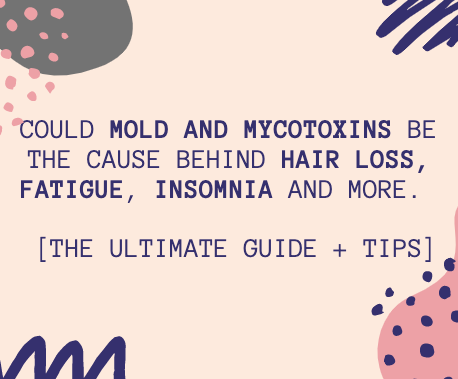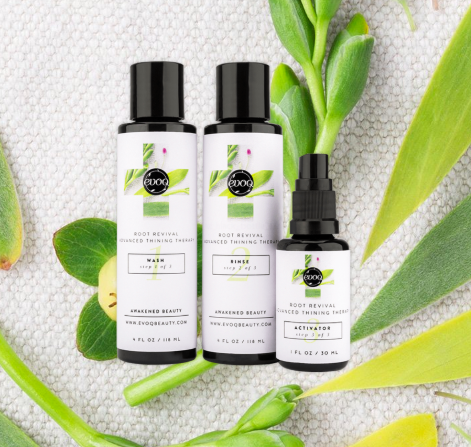MOLD can make you CRAZY LAZY and HAZY!
But have you thought about hair loss?
If you or someone you love has been struggling with the challenging and often life-altering side effects that come with toxic mold exposure, you know the journey to recovery can be long and tedious.
Some of you may know that I was affected by hidden mold in my ORGANIC salon for over 6 years, and nearly lost my life.
I’ve also witnessed many clients go through this same story - hidden mold, later to be discovered - and delayed severe health conditions to recover from. I’ve seen this through immune deficiencies, skin rashes to hair loss.
Toxic Mold Exposure: Cause Of Health Symptoms
Toxic mold exposure can cause health symptoms, including hair loss.
First, toxic mold exposure is a hidden cause of many health symptoms, including hair loss.
Second, there can be many factors behind the loss of hair you are experiencing. To find solutions, it is important to get informed and to explore all of the possible reasons behind your hair loss.
To go on, many different types of mold can be found inside and outside of the home. Besides, different variations of mold have a different effect on the body.
Mold produces spores.
These spores are released into the air and they float and make their way around your home. Moreover, the reason it is dangerous for us is that we inadvertently inhale those small spores.
When mold spores enter the body, they trigger an allergic reaction.
As a response to allergens, the human body releases histamines.
>>>>> The goal of histamines is to protect the body from intrusions.
However, histamine release leads to inflammation within the body.
>>>>> Ultimately, this swelling disrupts blood flow within your capillaries, which causes mal-oxygenation of the hair.
All in all, when your hair does not get the oxygen it needs, it is not adequately nourished.
Without the nutrition that it needs, hair becomes brittle and weak, and ultimately it will begin to fall out.
What is mold?
Further, mold is typically found in warm, moist environments. You will find it inside and outside your home. In humid conditions, mold can grow at an extremely rapid rate. It can also become tough to destroy in a wet environment that encourages the growth of mold.
The molds that you must be most cautious of are those that emit mycotoxins. This type of poison can do a lot of damage to your body and your overall health. Black mold is an example of a mold that releases mycotoxins.
What Is Black Mold?
You may have already heard of black mold (Stachybotrys Chartarum). It is black in color and quite easy to identify. At times, it can have a grey/green look to it. You will usually find it growing in warm, moist sections of the home. It likes to grow on surfaces like wood, board, paper, and lint.
Aside from its distinct color, black mold has a distinct odor to it as well. An inspector or someone experienced with mold will recognize the smell right away. Most people describe this smell as being musty.
If you live in a climate that is naturally warm and moist or your home is warm and humid. Mould and its harmful effects are something you should know about and keep an eye open for.
If you are exposed to an environment that is moist and warm, and you are also experiencing hair loss, it is important to consider the possibility that black mold might cause your hair loss.
When you inspect your home for mold, pay special attention to areas of the house that are typically damp. Mould is most often found in places like the bathroom, basement, and also crawlspaces that you rarely enter.
The effect that black mold has on your health and your overall wellness system will very much depend on how long you have been breathing it in. Long-term exposure can lead to increasingly severe health problems.
Treatment for Hair Loss Caused by Mold
Be sure to address any problems with mold in your house as quickly as possible. Typically, symptoms will remain until you are no longer exposed to black mold, but it can be necessary for certain people to detox from mold. This can be done through certain herbs, enzymes, etc. There are DR specialized in the sick-building-syndrome.
What is the best way to remove mold from your home? First, carefully search your entire home for mold. You can take this a step further by contracting a mold testing service.
If mold is found in your home, removing it is a matter of urgency. Be sure to use a HEPA vac in your home on a regular basis. This will reduce mold spore and thus improve your allergies.
Will Hair Grow Back?
f you have experienced hair loss, be encouraged by the fact that this is a condition that can be reversed. More than likely regrowth will be slow, but it will come. The key is to make sure that you are no longer exposed to mold or its spores.
The reason that your hair can regrow after hair loss from mold exposure is that your hair follicles have not died. They are in a dormant state. Once you are no longer exposed to mold, those hair follicles can reactivate and function again.
Symptoms of Exposure to Black Mold
If you live in the moist conditions described above and you recognize the symptoms below, it is important to inspect your home for mold fully:
Chronic coughing
Chronic fatigue
Eye irritation
Fever
Mucous membrane irritation (mouth, nose, and throat)
RashesSneezing
Black mold is a serious problem that should be dealt with as soon as you become aware that there is a problem. Its impact on your health can be troublesome, and this only becomes worse the longer you
Hair Loss from Fungal Infections
Another reason that you could be losing your hair is from fungal infections that are similar to mold.
Fungus causes an infection of the skin’s outer layer.
When you have an infection from a fungal infection, it looks different from hair loss from mold allergies.
Fungal infections create hair loss that is patchy. You will first see a pimple on the scalp, which later turns red. The hair falls out, and the area becomes itchy and flaky. You may also experience inflammation of the skin, and your skin could also peel or become scaly.
Fungal infections spread very easily among individuals. Anyone with a weak immune system has a higher risk of becoming infected. Fungal infections are also often the reason behind hair loss in children.
Other Allergies Cause Hair Loss
Mold is not the only thing that can cause hair loss.
Anything that causes an allergic reaction in your system for too long a period can lead to loss of hair.
Everyday things found in every home can result in allergic reactions. Things like pet dander, dust mites, and their excretion, and even certain biological enzymes in laundry detergent.
Low-Mold Diet Tips
A low mold diet is designed to support your body in healing from mold illness in three ways:
It prevents mycotoxins from accumulating in your body by limiting your exposure to potentially contaminated food sources.
It focuses on restoring nutrient deficiencies and imbalances that are caused by mold exposure.
It boosts your body’s immune function and ability to repair itself by minimizing inflammatory foods that suppress your immune system.
It reduces exposure to refined carbohydrates that feed candida and yeast.
What Foods Should I Avoid on the Low-Mold Diet?
When it comes to following a low-mold diet, you’ll want to strictly avoid foods that are chock-full of sugars and additives. These fuel fungal growth and could exacerbate your symptoms.
You’ll also want to avoid foods that are notorious for being contaminated with mold.
To make it simple, I like to break these down into the following three categories:
Sugar-Laden Foods
Sugars are one of the primary sources of fuel for candida or mold. Sugar, in particular, can be sneaky because it can go by many different names and may be hidden in places you wouldn’t expect – even in foods you might consider “healthy”.
When following the low-mold diet, you should avoid:
Table sugar
Glucose
Lactose
Fructose
Mannitol
Sorbitol
Honey
Maple syrup
Molasses
Candy
Baked goods
Certain fruits also have a notoriously high sugar content and should be avoided when detoxing from mold.
These include:
Pineapples
Mangoes
Bananas
Melons
Oranges
Grapes
Dried fruits and fruit juices
While sugar is typically the biggest dietary culprit that contributes to fungal growth, fast-absorbing carbohydrates and man-made additives can also promote mold growth – which leads us to our next category of foods to avoid.
Packaged and Processed Foods
Processed and pre-packaged foods almost always contain sugars, simple carbs, and/or additives that will fuel fungal growth in the body.
You’ll want to stay away from:
Canned foods: Baked beans, soups, ready-made sauces
Pre-packaged meals: Ready-made meals, breakfast cereals, frozen foods
Processed drinks: Soft drinks, fruit juices, flavored water, energy drinks
Bottled condiments: Vinegar, mayonnaise, pickles, soy sauce, mustard, relish
Try getting in the habit of reading the ingredient list of any product before you buy it. If it has more than five ingredients or is full of things you don’t recognize – it’s probably best to avoid it while on the low-mold diet.
Mold and Yeast Containing Foods
Some examples are:
Cheese and sour milk products: Buttermilk, sour cream, cream cheese, aged cheese
Nuts: Peanuts, cashews, walnuts, Brazil nuts
Dried fruit: Raisins, apricots, prunes, figs, dates, etc.
Grains: Wheat, rice, oats
Packaged and smoked meats: Sausages, hot dogs, corned beef, pastrami, smoked fish, ham, bacon
Edible fungi: Mushrooms, truffles
Alcoholic beverages: Beer, wine, cider, liqueur, whiskey, gin, rum, tequila, etc.
Fermented foods should be avoiding in those with histamine intolerance
While this list may seem restrictive, the good news is, there are still plenty of delicious foods allowed on the low-mold diet.
Foods Are Allowed on the Low-Mold Diet
Foods to Eat in Moderation:
Foods you can incorporate into the low-mold diet in moderation include:
Gluten-free grains: Brown rice, quinoa, buckwheat, millet, teff, certified gluten-free oats
Starchy vegetables and legumes: Sweet corn, potatoes, beans, peas, lentils, sweet potatoes, squashes, turnips, parsnips
Low-sugar fruits: Berries, apples, pears, peaches, avocadoes
It’s ok to incorporate these foods into your diet on occasion, but try building the majority of your meals around the foods in the next category.
Foods to Eat Freely:
When it comes to the food you consume while following a low-mold diet, quality matters – a lot! When purchasing meat, opt for organic, pasture-raised, and grass-fed options.
When it comes to fish and seafood, wild-caught is always a superior option. And when it comes to any kind of produce, always look for organic.
Foods to indulge in as much as you’d like while on a low-mold diet:
Poultry (pasture-raised, organic only): Chicken, eggs, turkey, quail, pheasant
Fish (wild-caught only): Salmon, tuna, anchovy, sardines, flounder, catfish, caviar
Other meats (grass-fed only): Beef, goat, lamb, buffalo, wild game, rabbit
Raw nuts and seeds: Sunflower seeds, pumpkin seeds, flax seeds, chia seeds, almonds, pecans, sesame seeds
Leafy greens: Romaine, kale, collard greens, spinach, turnip greens, green and red cabbage
Root vegetables: Carrots, onions, radishes, garlic
Gourd vegetables: pumpkins, squash, eggplants, zucchini
Other vegetables: Cucumbers, brussel sprouts, asparagus, artichokes, broccoli, cauliflower, bell peppers
Spices: Pure vanilla, cinnamon, cayenne pepper, pink Himalayan salt, wasabi, horseradish
Herbs: Parsley, cilantro, basil, chives, mint, oregano, rosemary, sage, thyme, tarragon, etc.
Healthy fats: Extra virgin olive oil, coconut oil, coconut milk, ghee, organic butter
Beverages: Filtered water, mineral water, non-fruity herbal teas, fresh vegetable juice
Building your meals around these nutrient-dense, whole foods will equip your body with the nutrients it needs to properly heal and detox.
Mold and Cravings
The simpler the carbs, the better. But mould would really prefer you go straight for the sugar.
People on long-term steroid medication, mold in the gut becomes a dense biofilm.
This biofilm hosts the gut fungus candida - which steals the nutrients for itself, leaving our intestine deprived.
Mold sufferers are craving these carbs and sugars because the candida is stealing it!
Getting Rid of Moldy Foods
If you’ve been suffering from the symptoms of toxic mold exposure, chances are you’re chomping at the bit to implement strategies to help alleviate your symptoms. But before you head to the fridge or grocery store and start whipping up a meal, it’s important to assess any food you’re planning on using.
Are There Any Other Ways to Enhance Mold Detoxification?
When you’re fighting mold illness, the symptoms can feel overwhelming and your recovery time may or may not be quick. On top of following the low-mold diet, you can enhance your detoxification and significantly cut your recovery time down by using the following strategies.
Use Detox Binders:
Detox binders are designed to “bind” to toxins in your body so they can be safely eliminated.
The most effective detox binders that I recommend include:
Activated Charcoal
Upgraded Coconut Charcoal
Binders
G.I. Detox
Supplements that aid in facilitating detoxification:
Glutathione
Milk Thistle Extract
R-Lipoic Acid
Quercetin
N-Acetylcysteine
Ways to Prevent Mould From Growing in Your House
Mould can grow on a surface when moisture is there for 24-48 hours. To prevent that from manifesting:
Do not leave wet towels or swimmers on a wooden surface like a wooden chair, wooden tablet, window sill etc.
Clean up right after a spill on wood.
Use the kitchen fan on.
When having a hot (steamy) shower, use the exhaust fan.
Use a dehumidifier on the lower levels of your house and monitor your humidity.
Don’t have cupboard boxes on the floor in store rooms.
Don’t store your possession under your bed. Let there be a free flow underneath.
When building storage units, put it on stilts so there is space underneath.
Build with bricks, not sticks (wood).
Get an air filter. Or use your lungs. However, one you can change, and the other you can’t. Change the filter regularly.
“Dust with gusto” - dust your house.
Dust - one of the easiest ways to feed mold.
How Long Does It Take to Get Mold Out of Your System?
The answer to that question is – it depends. Exactly how long it’ll take you to recover from mold illness depends on three main factors:
1. Length of Exposure:
This is the single greatest factor in determining how long it will take for mold to get out of your system. If you’ve been exposed for long periods of time, such as years, you’re likely to have mold buildup in your body.
Typically, the longer the exposure, the longer the recovery time. This is why removing any sources of mold exposure is the very first step in recovering from mold illness. If you fail to remove the sources of mold exposure – whether environmental or through the foods you eat – you may never be able to fully heal.
2. Type of Exposure:
Nearly 90% of all molds don’t affect the majority of the population due to them being nonpoisonous. But for those with fungal allergies, even these “harmless” molds can cause big problems.
And, if you have fungal allergies and you’re unlucky enough to be exposed to the 10% of poisonous molds – your recovery is expected to take longer than most. This is thanks to the toxic metabolites produced by poisonous molds known as mycotoxins. These mycotoxins can accumulate in your body and cause damage over time.
RESOURCES
To learn more about mold, make sure to check out the Awaken Beauty Podcast Episode with Dr Jill where you can dive deep into how you can further protect yourself from mold!
References
Dr Jill Crista
Dr. Crista’s Website, Instagram & Facebook
Dr. Crista’s Book – Break the Mold
Dr Jill Carnihan/Sandra Bloom Article Reference
https://sanitred.com/symptoms-of-toxic-black-mold-exposure/
https://www.cpsc.gov/s3fs-public/CPSCStatementmoldmycotoxinhealtheffectsJuly2015.pdf
https://www.fsis.usda.gov/wps/wcm/connect/a87cdc2c-6ddd-49f0-bd1f-393086742e68/Molds_on_Food.pdf?MOD=AJPERES
https://www.sinusitiswellness.com/how-long-will-my-recovery-take/
Testing for Mold
Urine test for mycotoxins. Mycotoxins that leave the body. But not for all as some people have impaired detox symptoms they can’t get these toxins transported to the urine. - Reduces foods high in mycotoxins before doing this test.
such as the Great Plains MycoTOX profile and Vibrant Wellness both use good technology.
Since sick patients may have their mycotoxins sitting in their cells and not being eliminated, do not take glutathione or binders for 48 hours before the test, so the test shows true levels.
Blood tests - including Immune globulin reaction to candida albicans for candida overgrowth.
Shoe maker eye test.
Stool - can check for fungal overgrowth in the gut, which means fungus burdening all over the body. Don’t take probiotics before this test.
organic acid - Great Plains -
Natural Killer Cell function test - how active they are. below 7 = deeply affected.
MARCoNS (Multiple Antibiotic Resistant Coagulase Negative Staph) and the sample should be sent to Microbiology DX in Massachusetts. - For CIRS. Chronic Inflammatory Response Syndrome.











